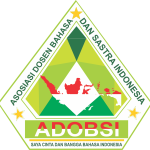THE NAMES OF ASAHAN AS PRAYER MEDIA IN THE NELONI TRADITIONAL CEREMONY IN PONOROGO REGENCY (ETHNOLINGUISTIC STUDY)
Abstract
The Javanese are the largest ethnic group in Indonesia. Javanese society has a characteristic that is fond of carrying out traditions related to life, such as the life cycle tradition, namely the neloni tradition. The people in Ponorogo Regency are Javanese people who have lived through a long period and various problems related to their lives so that a cultural system is formed in their identity. The neloni tradition according to the Ponorogo community is a tradition to ask for safety and blessings when a pregnant woman is about three months old. In the neloni tradition, there are offerings or sharpening devices. Sharpening has various forms and names. The focus of this research examines the meaning of "name" or "term" asahan as a prayer medium in the Neloni traditional ceremony in Ponorogo Regency. Asahan can be in the form of offerings or food that is formed according to the purpose of holding the traditional ceremony. The method of collecting data is done using interviews and observations of the community who carry out the tradition and who understand the tradition in Ponorogo Regency. After analyzing the data, the results obtained are 17 names of asahan which have the meaning of a medium of prayer asking for safety, happiness, and performance.
Keywords
Full Text:
PDFReferences
Adriana, I. (2011). Neloni, mitoni atau tingkeban: (Perpaduan antara tradisi Jawa dan Ritualitas masyarakat muslim). KARSA Journal of Social and Islamic Culture, 19(2), 239–247.
Deursen, V.A. J. A. M., & Dijk, V.J. A. G. M. (2019). The first-level digital divide shifts from inequalities in physical access to inequalities in material access. New Media and Society, 21(2), 354–375. https://doi.org/10.1177/1461444818797082
Ekowati, V. I. (2015). Tata cara dan upacara seputar daur hidup masyarakat Jawa dalam Serat Tatacara. Diksi, 15(2), 204–220. https://doi.org/10.21831/diksi.v15i2.6608
Foley, W. A. (1997).Language. in Anthropological linguistics: An introduction. Blackwell Publishers, 46(1), 229-234. https://doi.org/10.2307/412430
Koentjaraningrat. (2000). Kebudayaan, mentalitas dan pembangunan (p. 151). http://books.google.com/books?id=94QpZ-x1l7QC&pgis=1
Listi, H., & , Irma Apriliyani Rahayu, S. R. (2019). Bentuk Istilah-istilah upacara panggih pernikahan adat Jawa kajian etnolinguistik. LITE: Jurnal Bahasa, Sastra, Dan Budaya, 15(2), 204–216. https://doi.org/https://doi.org/10.33633/lite.v15i2.2538
Magnis-Suseno, F. (1984). Etika Jawa sebuah analisa falsafi tentang kebijaksanaan hidup orang Jawa. Jakarta: PT Gramedia Pustaka Utama (Vol. 3, Issue 2).
Na’im, A. & H. S. (2011). Kewarganegaraan, suku bangsa, agama dan bahasa sehari-hari penduduk Indonesia. in Electronic components & applications. Jakarta: Badan Pusat Statistik.
Nugroho, A., & Susilowati, H. (2021). Senggakan dangdut koplo music show: music anthropolinguistic study. 2(1), 1–7.
Purwastuti, A. & R. (1991). Nilai etik yang terkandung dalam upacara Tingkeban. Jurnal Cakrawala Pendidikan, 1(10), 67–78.
Rais, H. W. A. (2017). Kearifan Lokal dalam Bahasa dan Budaya Jawa: Studi Kasus Masyarakat Nelayan di Pesisir Selatan Kebumen Jawa Tengah (Kajian Etnolinguistik). Surakarta: UNS Press.
Riana, I. K. (2009). Linguistik budaya: kedudukan dan ranah pengkajiannya. Jakarta: Kompas.
Sulaksono, D., Lestari, W. D., Waluyo, B., & Islahuddin, I. (2021). Javanese Belief in the Ceremony of Bersih Desa With Wayang Kulit Play. El-HARAKAH, 23(2), 257–272. https://doi.org/10.18860/eh.v23i2.12858
Sutopo, H. B. (2006). Metode penelitian kualitatif. Surakarta: Universitas Sebelas Maret Press.
Wijayanti, K. D. (2019). Wayang existence in the islamization for traditional javanese people. El Harakah, 21(1), 125. https://doi.org/10.18860/el.v21i1.6279
Refbacks
- There are currently no refbacks.






